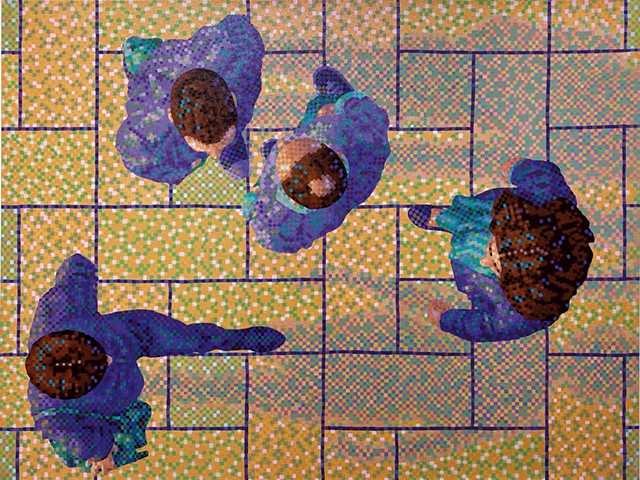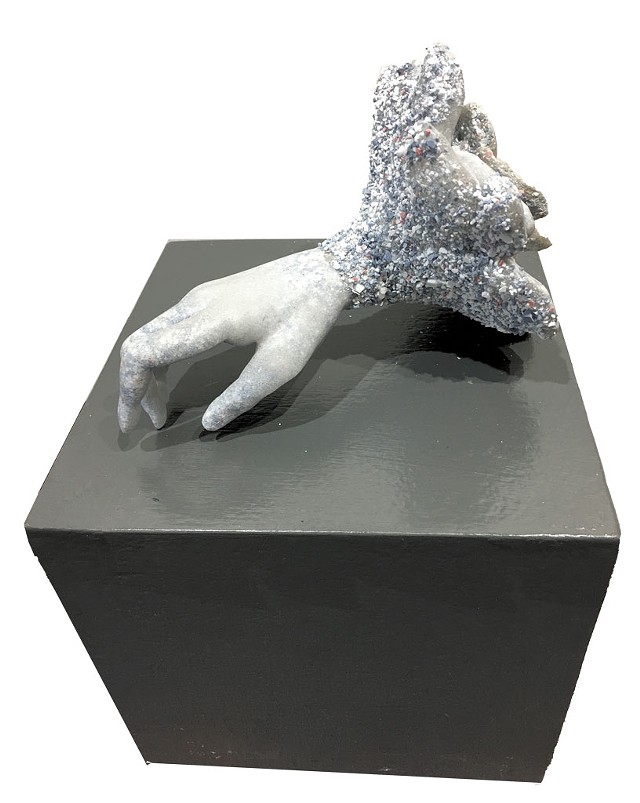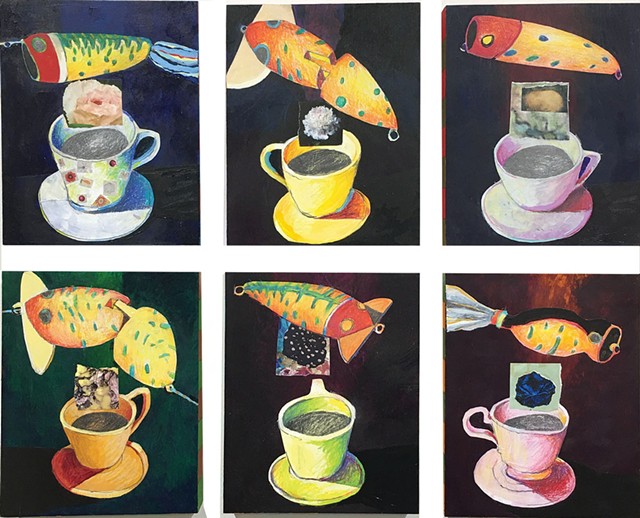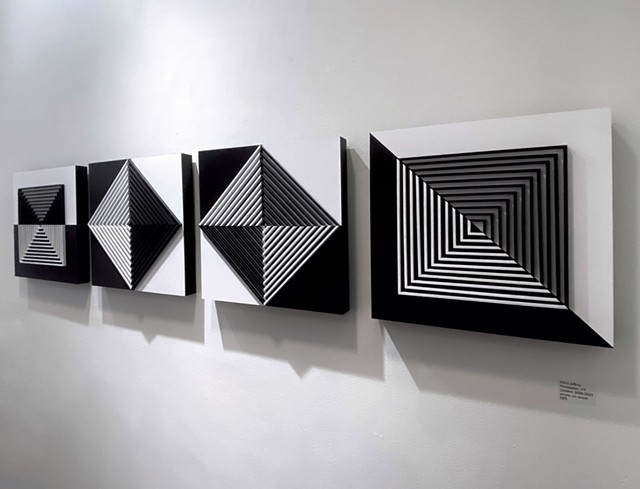
- Courtesy
- "Overlook #22 Four Shadowing" by Matthew J. Peake
Repetition is everything; we'd scarcely learn anything without it. Practice makes perfect, we're told, and that holds true whether tying our shoelaces, nailing a guitar solo or piloting an aircraft. Doing something over and over again is how we manage not to be dolts.
If the brain is wired to recognize patterns, is it any wonder that repeated motifs are so common — and so innately pleasing to the eye — in art and design? Cognitive science may not have been the impetus behind the exhibition "One + One Is Greater Than Two," at Studio Place Arts in Barre, but its theme is on point: multiples, patterns and relationships. Nearly 30 artists responded with works in a variety of interpretations and mediums, from paint to ceramic, wool to Wite-Out.

- Courtesy
- Sculpture from "Cuffed" series by Leslie Fry
Leslie Fry truly took the assignment to heart — and hand. According to SPA executive director Sue Higby, she was the only artist who met the curatorial mission with not only multiple pieces but more than one medium. Ten of Fry's untitled hand sculptures in painted and pigmented resin are displayed on tables near the gallery's front door; some are from her "Cuffed" series. The hands are smaller than life-size, with slender, tapered fingers. They recall Renaissance paintings of delicate ladies who have not known manual labor. There the similarity ends.
Fry produced her resin hands in a rainbow of colors and paired them with botanical or architectural elements. One is "cuffed" with a nautilus shell, another with a many-petaled blossom. A slightly creepy variation is two hands conjoined at the wrist and colored bright yellow and orange. Fry's gouache-and-monotype print and an ink transfer on vintage linen — both featuring multiple hands — hang on opposite walls.
Marcie Scudder's creation "My Mother's Garden" is draped gracefully in the gallery's front window. It consists of a multitude of circular shapes cut from paper, these printed with images of flowers, and strung together like sculptural kudzu.

- Courtesy
- "Drones Over Coffee #6-11" by Arthur Schaller
Many contributions to the exhibit rely on both repeated elements and a neat symmetrical presentation. Arthur Schaller lined up six small, amusing acrylic and collage paintings on wood that each depict "Drones Over Coffee." Kristen Dettoni arranged four square framed pieces from her "Braille Series," which used a needle punch on off-white sheep's wool to produce dots that mean words to people with vision loss. Visitors are usually forbidden to touch artworks in a gallery, but in this case it's frustrating not to do so.
Similarly, one wants to play with Stephany Komen Hasse's two sets of "Art Blocks." The pit-fired brown clay, in cubes, rectangular columns and arched shapes, is carefully arranged on display stands. As objets d'art, the earthy ceramics dramatically illustrate the effects of flame and botanical elements included in the kiln. As blocks, they evoke both childhood and the human inclination to build.
Dominique Gustin refers to another form of labor in her mixed-media piece "Timesheet." Sixteen encaustic paintings of various phases of dishwashing are mounted on blocks, which in turn are affixed to a wood backing. Both the activity depicted and the presentation of the images are repetitive and fastidious.
In Matthew J. Peake's two pieces, one in pastel and one in oil, multiplication appears on the canvas. In both works, he has painted four individuals as seen from above and in similar proximity to each other, walking on an orange tiled floor. All of them are wearing clothes in the same shade of purple-blue. Peake's "Overlook #22 Four Shadowing" is the larger work, in pixelated hues, and is mounted on a RoFrame — the artist's invention that allows the painting to be swiveled. Wall text invites viewers to shift the painting to one side or the other, observing how the diagonal view impacts their relative perspective.
Jessica Scriver encourages viewers to contemplate a mind-boggling multiverse of replication. Her "Untitled" acrylic painting on panel depicts an optical illusion of sorts: a matrix of white squares on deep blue whose arrangement challenges our sense of perspective — and reality. It looks like the answer to a math problem we can't even conceive.

- Courtesy
- "Untitled" by Chris Jeffrey
Chris Jeffrey's untitled group of wood constructions, painted in black and white and aligned horizontally, confound the eye in physical space. Each square contains within it another square formed from thin, parallel strips of wood. Depending on how they are painted and the angle at which one sees them, the shapes shift and shadow appears as gray. Jeffrey brilliantly expands the concept of multiple points of view. His creations are also feats of construction.
Several artists in the exhibit decided that two would do — that is, a pair of artworks that barely meet the parameters of the theme. But sometimes, perhaps, three is a crowd.









Comments
Comments are closed.
From 2014-2020, Seven Days allowed readers to comment on all stories posted on our website. While we've appreciated the suggestions and insights, right now Seven Days is prioritizing our core mission — producing high-quality, responsible local journalism — over moderating online debates between readers.
To criticize, correct or praise our reporting, please send us a letter to the editor or send us a tip. We’ll check it out and report the results.
Online comments may return when we have better tech tools for managing them. Thanks for reading.